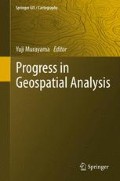Abstract
Urban growth is recognized as physical and functional changes due to the transition of rural landscapes to urban forms. The time–space relationship plays an important role in understanding the dynamic process of urban growth. This dynamic process consists of a complex nonlinear interaction between several components, i.e., topography, rivers, land use, transportation, culture, population, economy, and growth policies. Many efforts have been made to improve such dynamic process representations with the utility of cellular automata (CA) coupled with fuzzy logic (Liu 2009), artificial neural networks (Li and Yeh 2002; Almeida et al. 2008), Markov chains with a modified genetic algorithm (Tang et al. 2007), weight of evidence (Soares-Filho et al. 2004), nonordinal and multi-nominal logit estimators (Landis 2001), SLEUTH (Clarke et al. 1997; Jantz et al. 2010), and others (White and Engelen 1997; Batty et al. 1997).
This chapter has been improved from “Rajesh Bahadur Thapa and Yuji Murayama (2010), Urban growth modeling of Kathmandu metropolitan region, Nepal. Computers, Environment and Urban Systems, 35(1), 25–34,” Copyright (2011), with permission from Elsevier.
Access this chapter
Tax calculation will be finalised at checkout
Purchases are for personal use only
References
Almeida CM, Gleriani JM, Castejon EF, Soares-Filho BS (2008) Using neural networks and cellular automata for modeling intra-urban land-use dynamics. Int J Geogr Inf Sci 22:943–963
Batty M, Couclelis H, Eichen M (1997) Urban systems as cellular automata. Environ Plann B 24:175–192
Bhattarai K, Conway D (2010) Urban vulnerabilities in the Kathmandu valley, Nepal: visualizations of human/hazard interactions. J Geogr Inf Syst 2:63–84
Bonham-Carter G (1994) Geographic information systems for geoscientists: modeling with GIS. Pergamon, New York
Cadwallader MT (1996) Urban geography: an analytical approach. Prentice-Hall, New Jersey
CBS (2001) Population of Nepal (selected data–central development region). His Majesty’s Government of Nepal, Kathmandu
Clarke KC, Hoppen S, Gaydos LJ (1997) A self-modifying cellular automaton model of historical urbanization in the San Francisco bay area. Environ Plann B 24:247–261
Eastman JR (2009) IDRISI Taiga, Guide to GIS and remote processing. Clark University, Worcester
Godoy MMG, Soares-Filho BS (2008) Modelling intra-urban dynamics in the Savassi neighbourhood, Belo Horizonte city, Brazil. In: Paegelow M, Olmedo MTC (eds) Modelling environmental dynamics. Springer, Berlin, pp 319–338
Goodacre CM, Bonham-Carter GF, Asterberg FP, Wright DF (1993) A statistical analysis of spatial association of seismicity with drainage patterns and magnetic anomalies in western Quebec. Tectonophysics 217:285–305
Haack B (2009) A history and analysis of mapping urban expansion in the Kathmandu valley, Nepal. Cartogr J 46:233–241
ICIMOD/UNEP (2001) Kathmandu valley GIS database. Kathmandu: ICIMOD
Jantz CA, Goetz SJ, Donato D, Claggett P (2010) Designing and implementing a regional urban modeling system using the SLEUTH cellular urban model. Comput Environ Urban Syst 34:1–16
Klosterman RE, Pettit CJ (2005) Guest editorial: an update on planning support systems. Environ Plann B 32:477–484
KVUDC (2002) Long term development concept of Kathmandu valley. Kathmandu Valley Urban Development Committee, Kathmandu
Landis J (2001) CUF, CUF II, and CURBA: a family of spatially explicit urban growth and land-use policy simulation models. In: Brail RK, Klosterman RE (eds) Planning support systems: integrating geographic information systems, models and visualization tools. ESRI, Redlands, pp 157–200
Li X, Yeh AG (2002) Neural-network-based cellular automata for simulating multiple land use changes using GIS. Int J Geogr Inf Sci 16:323–343
Liu Y (2009) Modelling urban development with geographical information system and cellular automata. Taylor and Francis, Boca Raton
Pontius RG, Boersma W, Castella J, Clarke KC, de Nijs T, Dietzel C, Duan Z, Fotsing E, Goldstein N, Kok K, Koomen E, Lippitt CD, McConnell W, Sood AM, Pijanowski B, Pithadia S, Sweeney S, Trung TN, Veldkamp AT, Verburg PH (2008) Comparing the input, output, and validation maps for several models of land change. Ann Reg Sci 42:11–47
Portnov BA, Adhikari M, Schwartz M (2007) Urban growth in Nepal: does location matter? Urban Stud 44:915–937
Soares-Filho BS, Alencar A, Nespad D, Cerqueira GC, Dial M, Del C, Solozarno L, Voll E (2004) Simulating the response of land-cover changes to road paving and governance along a major Amazon highway: the Santarem-Cuiaba corridor. Glob Chang Biol 10:745–764
Tang J, Wang L, Yao Z (2007) Spatio-temporal urban landscape change analysis using the Markov chain model and a modified genetic algorithm. Int J Remote Sens 28:3255–3271
Thapa RB (2009) Spatial process of urbanization in Kathmandu valley, Nepal. PhD Dissertation. Graduate School of Life and Environmental Sciences, University of Tsukuba, Ibaraki
Thapa RB, Murayama Y (2009) Examining spatiotemporal urbanization patterns in Kathmandu valley, Nepal: remote sensing and spatial metrics approaches. Remote Sens 1:534–556
Thapa RB, Murayama Y (2010) Drivers of urban growth in the Kathmandu valley, Nepal: examining the efficacy of the analytic hierarchy process. Appl Geogr 30:70–83
Thapa RB, Murayama Y, Ale S (2008) Kathmandu. Cities 25:45–57
White R, Engelen G (1997) Cellular automata as the basis of integrated dynamic regional modeling. Environ Plann B 24:235–246
Author information
Authors and Affiliations
Corresponding author
Editor information
Editors and Affiliations
Rights and permissions
Copyright information
© 2012 Springer Japan
About this chapter
Cite this chapter
Thapa, R.B., Murayama, Y. (2012). Urban Growth Modeling Using the Bayesian Probability Function. In: Murayama, Y. (eds) Progress in Geospatial Analysis. Springer, Tokyo. https://doi.org/10.1007/978-4-431-54000-7_13
Download citation
DOI: https://doi.org/10.1007/978-4-431-54000-7_13
Published:
Publisher Name: Springer, Tokyo
Print ISBN: 978-4-431-53999-5
Online ISBN: 978-4-431-54000-7
eBook Packages: Earth and Environmental ScienceEarth and Environmental Science (R0)

